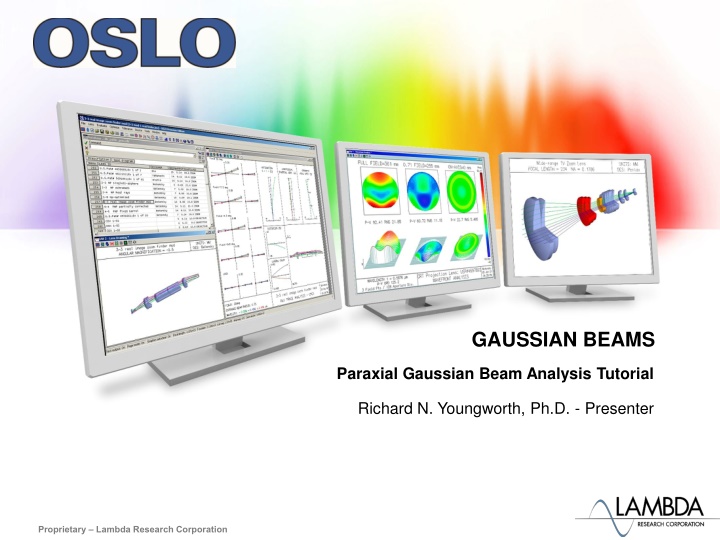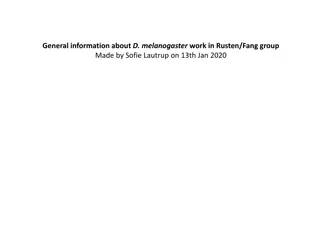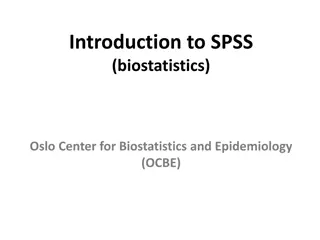
Paraxial Gaussian Beam Analysis Tutorial with OSLO Software
"Explore paraxial analysis of Gaussian beams using OSLO software for optical layout in laser systems. Learn theory, system setup, beam tracing, and more. Extensive capabilities beyond basics covered in this tutorial. Images and step-by-step instructions included."
Download Presentation

Please find below an Image/Link to download the presentation.
The content on the website is provided AS IS for your information and personal use only. It may not be sold, licensed, or shared on other websites without obtaining consent from the author. If you encounter any issues during the download, it is possible that the publisher has removed the file from their server.
You are allowed to download the files provided on this website for personal or commercial use, subject to the condition that they are used lawfully. All files are the property of their respective owners.
The content on the website is provided AS IS for your information and personal use only. It may not be sold, licensed, or shared on other websites without obtaining consent from the author.
E N D
Presentation Transcript
GAUSSIAN BEAMS Paraxial Gaussian Beam Analysis Tutorial Richard N. Youngworth, Ph.D. - Presenter Proprietary Lambda Research Corporation
OSLO facilitates optical layout in systems with lasers and Gaussian Beam sources In this tutorial set of videos we are covering paraxial analysis for non- skew (symmetric) Gaussian beams. 1. 2. 3. 4. 5. Review theory and OSLO documentation. Setting up the optical system. Running Gaussian Beam Tracing. Getting the beam waist in the paraxial image plane. Point Spread Function analysis. Will not cover the many additional topics in this general area. OSLO has a lot more capability than the basics shown here! Proprietary Lambda Research Corporation 2
OSLO facilitates optical layout in systems with lasers and Gaussian Beam sources In this tutorial set of videos we are covering paraxial analysis for non- skew (symmetric) Gaussian beams. 1. 2. 3. 4. 5. Review theory and OSLO documentation. Setting up the optical system. Running Gaussian Beam Tracing. Getting the beam waist in the paraxial image plane. Point Spread Function analysis. Proprietary Lambda Research Corporation 3
OSLO facilitates optical layout in systems with lasers and Gaussian Beam sources In this tutorial set of videos we are covering paraxial analysis for non- skew (symmetric) Gaussian beams. 1. Review theory and OSLO documentation. Gaussian beam parameters and propagation in fundamentals chapter of the OSLO optics reference. Impossible input beam settings. The start of the Lasers and Gaussian beams section in the examples chapter of the OSLO optics reference. Help system on "ABCD Gaussian Beam Analysis . Point spread function analysis help section (Plot PSF Map/Contour). a. b. c. d. e. Proprietary Lambda Research Corporation 4
OSLO facilitates optical layout in systems with lasers and Gaussian Beam sources In this tutorial set of videos we are covering paraxial analysis for non- skew (symmetric) Gaussian beams. 1. 2. 3. 4. 5. Review theory and OSLO documentation. Setting up the optical system. Running Gaussian Beam Tracing. Getting the beam waist in the paraxial image plane. Point Spread Function analysis. Proprietary Lambda Research Corporation 5
OSLO facilitates optical layout in systems with lasers and Gaussian Beam sources In this tutorial set of videos we are covering paraxial analysis for non- skew (symmetric) Gaussian beams. 2. Setting up the optical system. Open a new lens in OSLO and choose catalog lens. Pick a name for the lens (I am using GaussBeamEx ). Set the magnification to 0.5. Hit the OK button and the catalog lens database comes up. The exact lens choice is not critical but I am using a Melles Griot singlet with part number MG01LDX248 with a catalog EFL of 501.850 mm. Double click on the number choice. Go to the graphics window and hit the button to get a 2D plan view. Although we have set up the lens we still must make modifications for the incoming light. a. b. c. d. e. Proprietary Lambda Research Corporation 6
OSLO facilitates optical layout in systems with lasers and Gaussian Beam sources In this tutorial set of videos we are covering paraxial analysis for non- skew (symmetric) Gaussian beams. 2. Setting up the optical system (continued). Go to the wavelength spreadsheet, change the first wavelength to match a HeNe laser (632.8 nm) and delete the additional two wavelengths. Set the entrance beam radius to 2.0 mm. Set the object height to 1.0 mm. You may need to go to the paraxial set up editor in the lens spreadsheet editor. Run the paraxial setup analysis for the system. Since the wavelength has changed the paraxial magnification is not quite 0.5. Go to the paraxial set up editor and change the magnification to 0.5. Change the name of the lens to what you want (for example Gaussian Beam Example ). f. g. h. i. j. Proprietary Lambda Research Corporation 7
OSLO facilitates optical layout in systems with lasers and Gaussian Beam sources In this tutorial set of videos we are covering paraxial analysis for non- skew (symmetric) Gaussian beams. 1. 2. 3. 4. 5. Review theory and OSLO documentation. Setting up the optical system. Running Gaussian Beam Tracing. Getting the beam waist in the paraxial image plane. Point Spread Function analysis. Proprietary Lambda Research Corporation 8
OSLO facilitates optical layout in systems with lasers and Gaussian Beam sources In this tutorial set of videos we are covering paraxial analysis for non- skew (symmetric) Gaussian beams. 3. Running Gaussian Beam Tracing. Select Paraxial Gaussian Beam (ABCD) under the source menu. Specify a HeNe beam that has a beam waist of 0.25 mm and a waist distance of zero (located in the object plane). So the only number to change is the Waist ss (w0) to 0.25 mm (the lens units are mm). Push the print beam data button and review the data in the text window. Plot the beam spot size and investigate the beam using the slider. (Optional) We can place a dummy surface in the focal shifted location for the beam waist in image space. Repeat the analysis with the dummy surface. (Optional) You can use the notes section to store beam parameters. a. b. c. d. e. f. Proprietary Lambda Research Corporation 9
OSLO facilitates optical layout in systems with lasers and Gaussian Beam sources In this tutorial set of videos we are covering paraxial analysis for non- skew (symmetric) Gaussian beams. 1. 2. 3. 4. 5. Review theory and OSLO documentation. Setting up the optical system. Running Gaussian Beam Tracing. Getting the beam waist in the paraxial image plane. Point Spread Function analysis. Proprietary Lambda Research Corporation 10
OSLO facilitates optical layout in systems with lasers and Gaussian Beam sources In this tutorial set of videos we are covering paraxial analysis for non- skew (symmetric) Gaussian beams. 4. Getting the beam waist in the paraxial image plane. Under the source menu select Paraxial Gaussian Beam (ABCD) . Verify that a 0.25 mm beam waist is specified (or enter this value). Via laser theory, getting the beam waist in the paraxial image plane requires a beam radius of efl/m (the minus sign is due to the different sign convention for radii of the wavefront). Run the paraxial setup analysis (pxs). Note the cells for the paraxial magnification and EFL of the system. Enter the cell values for efl/m into the Wvf radius (R) cell. Hit the print beam data in text button. The output should now have the beam waist in the paraxial image plane. Review the output. To see the error message for an impossible input beam, try using a 0.50 mm beam waist. a. b. c. d. e. f. Proprietary Lambda Research Corporation 11
OSLO facilitates optical layout in systems with lasers and Gaussian Beam sources In this tutorial set of videos we are covering paraxial analysis for non- skew (symmetric) Gaussian beams. 1. 2. 3. 4. 5. Review theory and OSLO documentation. Setting up the optical system. Running Gaussian Beam Tracing. Getting the beam waist in the paraxial image plane. Point Spread Function analysis. Proprietary Lambda Research Corporation 12
OSLO facilitates optical layout in systems with lasers and Gaussian Beam sources In this tutorial set of videos we are covering paraxial analysis for non- skew (symmetric) Gaussian beams. 5. Point Spread Function analysis. Look at the Gaussian beam data from previous work and cite the wavefront incident radius of curvature at surface 1 (note the cell). If needed, select Paraxial Gaussian Beam (ABCD) under the source menu. Verify you have a HeNe beam that has a beam waist of 0.25 mm and a waist distance of zero (located in the object plane). Push the print beam data button and analyze the data in the text window. Change the object distance to match the magnitude of this wavefront radius of curvature (the radius of curvature should be negative so just enter the magnitude of the value). We must tell OSLO the calculation should be for a Gaussian beam. Open the paraxial set up editor in the lens spreadsheet editor and enter the spot size values at surface 1 that are in the text window. a. b. c. Proprietary Lambda Research Corporation 13
OSLO facilitates optical layout in systems with lasers and Gaussian Beam sources In this tutorial set of videos we are covering paraxial analysis for non- skew (symmetric) Gaussian beams. 5. Point Spread Function analysis (continued). Change the aperture divisions across the pupil for spot diagram to 41.05 for increased accuracy in the paraxial setup spreadsheet. You can then close the spreadsheet with the green arrow button. Change the entrance beam radius to 3 mm so the spot diagram grid approximates an untruncated Gaussian beam. Select the Evaluate>>SpreadFunction>>Plot PSF Scans command with default options to compute the PSF. Verify the spot size to the size predicted by the paraxial Gaussian beam analysis are essentially the same. Recall that since we have specified Gaussian beam parameters, OSLO is giving 1/e2 spot size values. d. e. f. Proprietary Lambda Research Corporation 14
OSLO facilitates optical layout in systems with lasers and Gaussian Beam sources In this tutorial set of videos we are covering paraxial analysis for non- skew (symmetric) Gaussian beams. 5. Point Spread Function analysis (continued). Calculate the point spread function value at the paraxial image plane and at the waist distance (print PSF value works nicely and note the waist location relative to the paraxial image plane). Verify the ratio of the irradiances for these two analysis is very close to the ratio of the ratio of the square of the beam waist divided by the beam half-diameter at the image plane. In a new graphics window, plot the point spread function at the beam waist position. Use Evaluate>>SpreadFunction>>Plot PSF Scans and enter a focus change matching the beam waist offset from the paraxial image plane (seen in the paraxial Gaussian beam output). You can right click the plot and change the ordinate plot scale as needed. The value should be consistent with the waist calculation. g. h. i. Proprietary Lambda Research Corporation 15
OSLO facilitates optical layout in systems with lasers and Gaussian Beam sources In this tutorial set of videos we are covering paraxial analysis for non- skew (symmetric) Gaussian beams. 5. Point Spread Function analysis (continued). Finally we simulate a truncated Gaussian beam. Enter a new surface above the catalog lens. Using data from the ABCD analysis, make this surface s aperture equal to the 1/e2 spot size value at that surface. Make the surface a checked surface, which ensures that it will truncate the beam. This aperture right at the stop location will now induce diffraction. Run the PSF routine in the same window as step i and observe the result. Note the 1/e2 spot size is larger and there is energy in a lobe around the central spot, indicative of a diffraction pattern. The beam is no longer a Gaussian. Note OSLO normalizes the PSF to the peak of a perfect PSF for the same pupil size and focusing distance so the irradiance normalizations are different for cases we ve run. j. k. l. Proprietary Lambda Research Corporation 16













